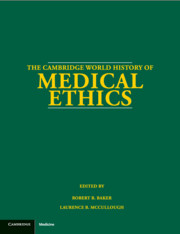Book contents
- Frontmatter
- PART I AN INTRODUCTION TO THE HISTORY OF MEDICAL ETHICS
- PART II A CHRONOLOGY OF MEDICAL ETHICS
- PART III DISCOURSES OF MEDICAL ETHICS THROUGH THE LIFE CYCLE
- PART IV THE DISCOURSES OF RELIGION ON MEDICAL ETHICS
- PART V THE DISCOURSES OF PHILOSOPHY ON MEDICAL ETHICS
- PART VI THE DISCOURSES OF PRACTITIONERS ON MEDICAL ETHICS
- PART VII THE DISCOURSES OF BIOETHICS
- 38 The Discourses of Bioethics in the United States
- 39 The Discourses of Bioethics in the United Kingdom
- 40 The Discourses of Bioethics in Western Europe
- 41 The Discourses of Bioethics in Post-Communist Eastern Europe
- 42 The Discourses of Bioethics in Latin America
- 43 The Discourses of Bioethics in East Asia
- 44 The Discourses of Bioethics in South Asia
- 45 The Discourses of Bioethics in Sub-Saharan Africa
- PART VIII DISCOURSES ON MEDICAL ETHICS AND SOCIETY
- Appendix: Biographies: Who Was Who in the History of Medical Ethics
- Bibliography
- Index
38 - The Discourses of Bioethics in the United States
from PART VII - THE DISCOURSES OF BIOETHICS
Published online by Cambridge University Press: 28 May 2012
- Frontmatter
- PART I AN INTRODUCTION TO THE HISTORY OF MEDICAL ETHICS
- PART II A CHRONOLOGY OF MEDICAL ETHICS
- PART III DISCOURSES OF MEDICAL ETHICS THROUGH THE LIFE CYCLE
- PART IV THE DISCOURSES OF RELIGION ON MEDICAL ETHICS
- PART V THE DISCOURSES OF PHILOSOPHY ON MEDICAL ETHICS
- PART VI THE DISCOURSES OF PRACTITIONERS ON MEDICAL ETHICS
- PART VII THE DISCOURSES OF BIOETHICS
- 38 The Discourses of Bioethics in the United States
- 39 The Discourses of Bioethics in the United Kingdom
- 40 The Discourses of Bioethics in Western Europe
- 41 The Discourses of Bioethics in Post-Communist Eastern Europe
- 42 The Discourses of Bioethics in Latin America
- 43 The Discourses of Bioethics in East Asia
- 44 The Discourses of Bioethics in South Asia
- 45 The Discourses of Bioethics in Sub-Saharan Africa
- PART VIII DISCOURSES ON MEDICAL ETHICS AND SOCIETY
- Appendix: Biographies: Who Was Who in the History of Medical Ethics
- Bibliography
- Index
Summary
INTRODUCTION
The word, “bioethics,” was fashioned in 1970 by a biological scientist, Van Rensselaer Potter, to name his vision of a new conjunction of scientific knowledge and moral appreciation of the converging evolutionary understanding of humans in nature (Potter 1970). Hardly had the word been uttered by its author than it was appropriated to identify a related but much narrower vision: the ethical analysis of a range of moral questions posed to medical practice by the advances in the biomedical sciences and technologies. In 1971, the Kennedy Institute of Ethics was founded at Georgetown University to pioneer the development of a new field of joint research that its the Institute's founder, Andre Hellegers (1911–1979), chose to call “bioethics,” Warren Reich of the Institute began to plan The Encyclopedia of Bioethics in 1972, in which he defined bioethics as “the study of the ethical dimensions of medicine and the biological sciences” (Reich 1978, ⅹⅸ–ⅹⅹ; Reich 1995a). In 1974, Daniel Callahan, who founded the other major research institute in this new field, The Hastings Center, wrote an influential article entitled, “Bioethics as a Discipline” in which he suggested that this new field could develop itself into a unique discipline, using both the traditional methods of philosophical analysis and sensitivity to human emotion and to social and political influences with which medicine was practiced (Callahan 1973). This emerging discipline should be designed to serve those who were faced with the crucial decisions that arise within medicine.
- Type
- Chapter
- Information
- The Cambridge World History of Medical Ethics , pp. 475 - 485Publisher: Cambridge University PressPrint publication year: 2008
- 2
- Cited by

